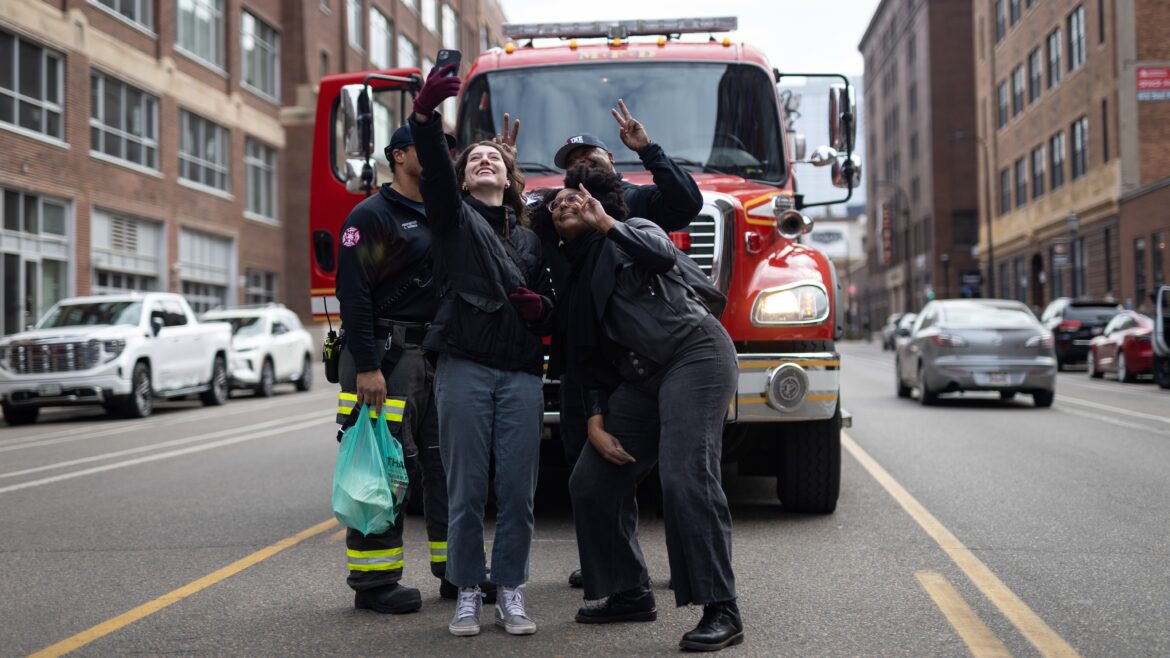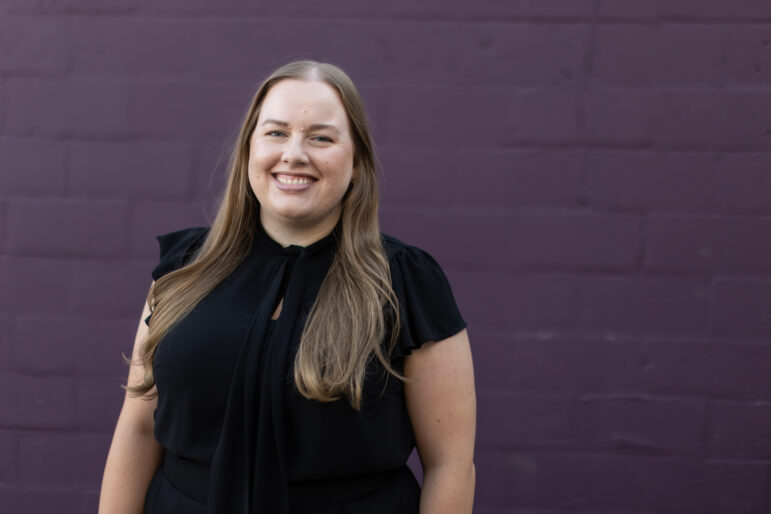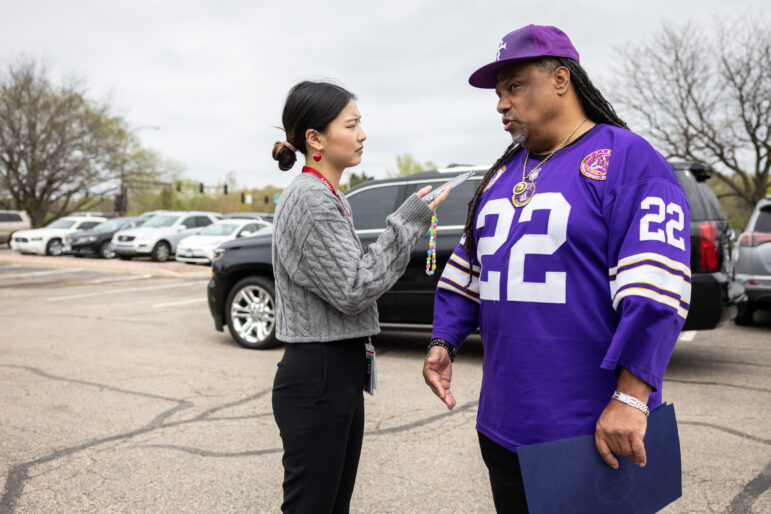New MPR initiative aims to ‘make news more approachable’ for younger audiences

Ben Hovland / MPR News
Anne Guttridge and Feven Gerezgiher pose for a photo with Minneapolis Fire Department responders March 7 after interviewing them during their lunch break about the reality TV show “Love Is Blind."
A new Minnesota Public Radio initiative announced May 7 is expanding the station’s efforts to serve younger audiences with multiplatform coverage of the topics they care about most.
Formed initially as the Street Team in the fall of 2022, the project, now titled Reverb, consists of five journalists ages 25-33 working on everything from investigative pieces to pop culture talkers, aiming to make compelling stories accessible on mobile, online and through social media. They also collaborate across the MPR newsroom with journalists of all ages to create content.

“The initiative is not only social media by any means, but that is where I see the greatest potential for connection with new audiences,” said Kaila White, a digital editor overseeing Reverb who joined MPR in 2022 from the Arizona Republic. “I love that on TikTok, and to a certain extent on Instagram, every piece of content is a new opportunity to reach an incredibly broad audience, because the algorithm will serve people based on their interests. It’s not as much about followers anymore as it is about just trying to create content that hits every single time.”
Knowing the audience
In 2020, millennials surpassed baby boomers as the United States’ largest generation. Gen Z, which makes up 20% of the U.S. population, is the country’s most ethnically and racially diverse generation. Gen Zers are also digital natives and “the first generation to grow up with the internet as part of daily life.”
Video Producer Anne Guttridge, who joined the Reverb team in February from TPT in St. Paul, said the best way to engage a younger audience is through video. It’s about delivering news in a specific way via a format and story structure younger people are “already primed to accept,” she said.
Recent reports from the Pew Research Center show that about a third of U.S. adults under 30 regularly get news on TikTok and trust social media for information almost as much as national news outlets. Recently, MPR surpassed 1 million likes on TikTok, thanks in big part to Reverb-created content.
The uncertainty surrounding TikTok’s future in the U.S. doesn’t worry Guttridge. She said in addition to its TikTok numbers, Reverb has built a strong audience on Instagram, Facebook video numbers are also strong, and the team is starting to invest in YouTube Shorts.
“We’re going to have content to post, and we’re going to have places to post that content no matter what happens with TikTok,” she said.
And younger adults are recognizing that Reverb is paying attention to what they care about, whether that’s the reality TV show Love Is Blind, deaths on a local college campus, a municipal cannabis dispensary or Miss Hmong Minnesota, Guttridge said. Recently, the Reverb team was covering campus protests and student organizers at the University of Minnesota, posting the content to social media.
“When the timing of things shifted, we followed up, and we made sure we went back out there to bring the story up to date so that those students could see themselves in the reporting in addition to getting a well-rounded story,” Guttridge said.
The team was also pop culture–savvy when it discovered the reality show Love Is Blind was filming in Minneapolis earlier this year. The show’s current season was Netflix’s most-streamed series in March and was watched for 6 million minutes. The team covered the Minneapolis news through a comprehensive story and two videos.
“So many people saw the videos,” said Feven Gerezgiher, a Reverb reporter with a community engagement and service background. “For people not familiar with MPR, they’re like, ‘Okay, I’m seeing this person’s face on my feed periodically.’ And that was an association with a news organization.
“I heard from one of our colleagues that their friends have said, ‘Do you even work at MPR? Because I’ve never seen you on TikTok,’” she continued. “For them, MPR is that. Even the fact that we are trying to tell more stories that are about and include young people, the nature of being out and telling those stories, interviewing them, reaching out for sourcing meetings — if they didn’t know about MPR, now they do. And then they start to think, ‘I actually have a story, and I want the media to know this.’”

Nicole Ki, a reporter who joined MPR in January 2023 from the Sioux Falls Argus Leader, said many story ideas come from engaging with Reverb’s audiences on social media and building trust with them.
“Some of our trans community and LGBTQ coverage has hit really well with our audience,” Ki said. “It’s something that people really care about. When I first joined, we covered the ‘trans refuge’ bill. We were trying to add to the coverage already out there that wasn’t inclusive or comprehensive. We tried to fill in the gaps where people still had very basic questions about what was happening.”
She added: “We’re trying to make news more approachable. A lot of times, we’re explaining it like we’re talking to a friend. We want to reach as many people as possible and explain it in a way that is easy to understand and that’s not intimidating to our audience.”
Making the investment
As the Street Team evolved, MPR brought in marketing staff to help with branding. After surveying 100 young adults in the fall of 2023 about names for the initiative, feedback proved Reverb resonated most.
“This was something we talked a lot about — the benefit of having a separate name,” said Gerezgiher. “We also looked at similar initiatives across other news organizations. 404 at the LA Times was a big one, where I saw how they were given permission to have a different tone and their own platform.”

MPR President Duchesne Drew said the station is constantly discussing taking content it’s already making and getting it in front of more people. But it’s also about creating something new to attract people who wouldn’t necessarily be drawn to what MPR is already producing.
“Reverb is a ladder in terms of thinking strategically about how to pull more young folks into our orbit,” said Drew. “And looking at, how do we provide more news and information that still aligns with our brand and with our values but in a way that’s going to attract 20-somethings as well?”
“All legacy media is hearing from young people that they’re looking for something different than what we’re offering up,” he said. “We know that just based on our ratings, based on their engagement. It’s not that they’re not consuming media. They’re not consuming our media at the clip we’d like. Absence is a signal. The truth of the matter is that we have, I would argue, a responsibility to figure out how we engage them in ways that are going to be appealing to them.”
Guttridge said it’s important for the Reverb team (which also includes digital producer Sam Stroozas) and MPR to be there for young adults because the way people consume media is constantly evolving and changing.
“At the moment, it’s a lot of focus on digital media, specifically video,” she said. “To show that we’re able to adapt and figure out these platforms sends a positive message to those audiences that we care enough to invest in them. And the fact that MPR created a position for video is huge — many newsrooms do not have that luxury.”
“I also think it’s important for us to reach those audiences, because they’re going to be the ones who will be around in 2050, and it’s going to be what makes us stick around as well,” Guttridge added. “It’s mutually beneficial to be there and just show up for those specific audiences and recognize that we have to adapt, we have to change, and we have to pay attention to what they want, and that’s not something that everyone is capable of doing. I recognize there are public media organizations across the board that don’t have the capacity.”
Measuring success
Measuring the impact of Reverb is challenging, said Gerezgiher, because it’s not just about data, although likes, follows and views are relevant. She’s had people tell her how a video has impacted them. An elementary school teacher recently showed a video to her classroom that Gerezgiher made explaining the new state flag. That video story also won a 2023 Midwest Broadcast Journalism Association first-place award for social media in the large market radio division. Gerezgiher has noticed an increase in younger people contacting her after watching her videos to share story ideas.
Drew says it’s important that MPR appears and performs effectively on social media, especially with so many young adults getting their news and information from those outlets.
“There’s a lot to be said about developing programming, any kind of real engagement, that centers the people you’re trying to serve and trying to work with,” said Drew. The fact that we’ve got some younger folks and some young people of color as part of it helping to shape what this is gives me confidence that we’re going to get it closer and closer to right over time.”
He said the good thing is that MPR is a “healthy legacy news organization” that has built “a strong bond and trust” throughout much of Minnesota.
“We’re working from a position of relative strength and scale,” he said. “[Reverb] doesn’t have to be an overnight success. It’s not like they’re on the clock, and if they don’t have it figured out in six months, we’re going to pack it in. We have some time, some runway, and we have resources to help show us what’s working and why. The truth is, it’s probably always going to be a bit of a moving target. The platforms we are on now and what they allow us to do, those things will continue to evolve, and we have to evolve with them.”






